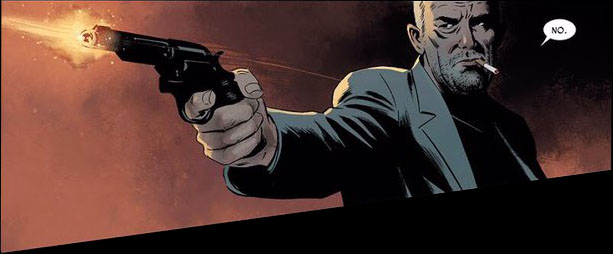On this page, there are two double bordered panels. In the main spread, there is a large monster getting punched in the face by Captain Marvel. In the first double bordered panel, this monster is crashing into a building in the background. Lastly, in the second double bordered panel, Carol is hovering over the defeated monster. As with before, each of these panels is a distinct moment of the fight. On the level of story, the punch is the beginning of this interaction, the monster crashing into the building is the middle, and then the monster laying defeated on the ground while Carol hovers over it is the end. Looking at the technique, we can see that the first panel shows Carol moving and the monster being moved by her. This panel is the full two page spread and is horizontal. The next panel, which is tilted slightly, shows the monster moving. Carol isn’t in it. Lastly, the final panel shows Carol and the monster, both still. This panel is larger than the last and tilted even more. The double border serves to signal these differences once again.
This goes to show that the creative team of a comic have control over all the elements of the page’s composition. What counts as the art and storytelling isn’t just limited to the contents of the panels but also the way they’re shaped and how they’re framed. The architecture of a comic is important for developing the book’s visual language and guiding how the reader experiences the story, and Captain Marvel #1 is a great example of how to use this power well.
Captain Marvel #1
Writer: Kelly Thompson
Artist: Carmen Carnero
Colorist: Tamra Bonvillain
Letterer: Clayton Cowles
Publisher: Marvel Comics
Check out Comics Anatomy: Velvet’s Perfect Page!
Harry Kassen is a college student and avid comic book reader. When he’s not doing schoolwork or reading comics, he’s probably sleeping. Catch his thoughts on comics, food, and other things on Twitter @leekassen.



